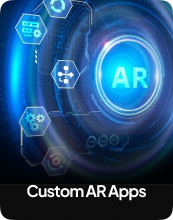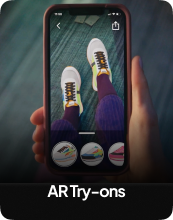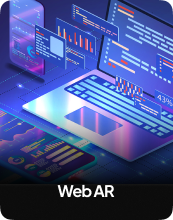
Software Development


Augmented Reality services are more than just technology, they are a fusion of digital creativity and real-world applications, crafted by our team of top tech talents. With specializations ranging from interactive design to advanced software engineering, our experts are at the forefront of AR development. Each AR solution is meticulously tailored to meet your unique business needs. Customize your own business world where your ideas come to life by the best in the business.






#1
Start by analyzing your business operations, customer interactions, and areas where AR can make a difference. Consider things like product visualization, customer engagement, training, or any specific challenges you're facing.
#2
Engage with AR experts or consultants who can help you navigate the technology and its potential applications for your business. They can provide insights, case studies, and recommendations based on your specific industry and goals
#3
Collaborate with experts to determine the specific features and functionalities you want in your AR solution. This could include elements like 3D modeling, real-time overlays, interactive content, or customized experiences tailored to your business needs
#4
Once you've outlined your requirements, the AR experts will design and develop a tailored AR solution. This process involves creating 3D models, integrating AR frameworks, and ensuring seamless interactions between digital and physical elements.
#5
Do user testing with a diverse group of stakeholders before the launch. Get feedback on usability, performance, and overall experience. By doing this, you can refine your solution and make sure it meets your target audience's needs. We can refine the AR solution based on your feedback. Usually, this involves improving the user interface, adding functionality, or improving performance.
#6
With a refined AR solution in hand, it's time to launch. Coordinate with your marketing and communication teams to generate excitement and awareness around the new AR capabilities.


AR provides interactive and immersive experiences that captivate customers, leading to longer engagement times and stronger brand loyalty.

Virtual and interactive product demonstrations can boost confidence in purchasing decisions, leading to higher conversion rates for businesses.

Early adoption of AR sets businesses apart from competitors, signaling innovation and a commitment to enhancing customer experiences.

AR analytics can provide businesses with valuable data on user behavior, preferences, and interactions, allowing for more informed decision-making.

AR can tailor experiences to individual preferences, offering personalized content and recommendations based on user interactions.

AR-powered marketing campaigns have the potential to go viral, creating buzz around a brand and reaching a wider audience.
Augmented reality (AR): a view of the real world with an overlay of digital elements. Mixed Reality (MR): a view of the real world with an overlay of digital elements where physical and digital elements can interact. Virtual reality (VR): a fully-immersive digital environment.
Top 10 augmented reality companies for business
Qualcomm
IntelIreland
HTC VIVE. VIVERSE - A Day in the Metaverse with VR, AR, AI, 5G & NFTs
NVIDIA
Niantic
Microsoft
Meta
For example, Coca-Cola used AR technology to create a campaign that allowed users to virtually try on sunglasses and share the experience on social media. Retail: AR technology is used in retail to allow customers to try on clothing and accessories virtually.
The Place app lets its users superimpose the virtual replicas of the IKEA furniture of their choice in their real homes by the aid of the AR technology. It provides shoppers with a more flawless look as to what that particular furniture might look like once placed in its intended spot.
Various reports show the size of the AR market is growing, and at a pretty incredible rate too. According to Grandview Research, in 2021, the value of the AR market was around $25.33 billion, but the space is expected to grow at a CAGR of approximately 40.9% through to 2030.
AR increases engagement and interaction and provides a richer user experience. Research has shown that AR increases the perceived value of products and brands. Well-implemented AR activity conveys innovation and responsiveness from forward-thinking brands.
Drive innovation through AR collaborations.

Get our rates card

Thanks for contacting us!
Your request has been submitted, please wait for a response.
